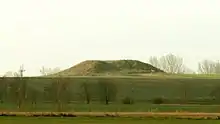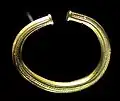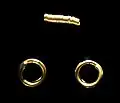Leubingen tumulus
The Leubingen tumulus (German: Fürstengrab von Leubingen) is an early bronze age "princely" grave of the Leubingen culture, (which, after further finds at Auntjetitz became known as Auntjetitz or Unetice culture), dating to about 1940 BC. It is located near the hills of Kyffhäuser in Leubingen, an Ortsteil of Sömmerda in the eastern German state of Thuringia.
Fürstengrab von Leubingen | |
 The Leubingen tumulus | |
 Location in Germany | |
| Location | Leubingen, Sömmerda |
|---|---|
| Region | Thuringia, Germany |
| Coordinates | 51°11′25″N 11°10′11″E |
| Type | tumulus |
| History | |
| Founded | c. 2000 BC |
| Periods | Early Bronze Age |
| Cultures | Unetice culture |
| Site notes | |
| Discovered | 1877 |
| Archaeologists | Friedrich Klopfleisch |
Excavations
The site was first unearthed in 1877 by Jena art professor and archaeologist Friedrich Klopfleisch (1831–1898). He was working at the behest of the Historische Kommission der Provinz Sachsen. Klopfleisch kept a diary during his work and latter submitted an official report on the findings. Unfortunately, there are important differences between his original notes and the final report. Both the location of the burial chamber and of the grave goods within the chamber vary. During the excavations no second body is mentioned (see Description below), only a few bone remains. Today, the diary is deemed the more reliable source.[1]: 183
After the excavations were finished, the mound was filled in again. In 1912, the local Königlicher Landrat ordered the Leubingen authorities to prevent its agricultural use.[1]: 183
During road construction in 2011 excavations on the site nearby have also revealed the remains of one of the largest buildings in prehistoric Germany, a longhouse 44 m x 10.50 m, or 470 square meters (5,057 square feet) of floor space, a trove of bronze objects, and a cemetery of 44 farmers.[2]
Dating and evaluation
Dendrochronologic testing of the oaken beams has placed the grave at circa 1942 BC.[1]: 180
The tomb is considered one of the most opulent elite grave of the Early Bronze Age in Western Europe. Due to the effort required for its construction and the quality of the grave goods, the buried person must have been of great importance.[1]: 180
Description
Mound and chamber
The earthen mound is 7 metres (23 ft) high and contains a burial chamber of 3.90 by 2.10 metres (12.8 by 6.9 ft) with a maximum height of 1.70 metres (5.6 ft).
The original height of the mound was around 8.5 metres (28 ft) and its diameter was 34 metres (112 ft). Around 210 cubic-meters of stones and 3,600 cubic-meters of earth were moved in its construction.[1]: 180
Inside the earthen mound is the burial Chamber, which has roughly the form of a hut/house of the time. It has a saddle-shaped roof made out of heavy oak beams covered with stones.[1]: 180
Contents of the grave

In a central position lay the body of a man about 50 years old.
According to Klopfleisch's final report, draped over the man's loins at an angle of ca. 40° was the body of a young man. This was not mentioned in his earlier notes, however.[1]: 183
- Aside his right shoulder:
- An open bracelet
- Two pins
- Two rings
- A spiral made out of gold.
- At his feet:
- A stone battle-hammer which was pierced
- A rectangular stone (anvil?)
- Two bronze edge-axes (axe with elevated edges to prevent it from moving too much on the handle it was attached to)
- Three bronze chisels
- Three bronze dagger blades which were placed in leather and oak bark scabbards
- Also found there was the blade of a dagger (de:Stabdolch)
- In a corner of the burial chamber stood a large ceramic pot, with brown and black decorations, with little ears on the shoulder.
The findings are now part of the permanent exhibition of the Halle State Museum of Prehistory.
Gallery
 Illustration 1 from Klopfleisch's hand-drawn/-written report
Illustration 1 from Klopfleisch's hand-drawn/-written report Illustration 2 from Klopfleisch's hand-drawn/-written report
Illustration 2 from Klopfleisch's hand-drawn/-written report Gold armring
Gold armring Gold rings and spiral
Gold rings and spiral Gold pins
Gold pins Massive stone axe, a relic from the 5th millennium BC[5]
Massive stone axe, a relic from the 5th millennium BC[5] Bronze axe
Bronze axe Bronze dagger
Bronze dagger
Surroundings
Between the 8th and 11th century AD, the local (at the time Slavic) community established a cemetery of about 70 graves in and around this manmade hill.
See also
- Grave of Helmsdorf
References
- Meller, Harald, ed. (2011). Bronzerausch - Spätneolithikum und Frühbronzezeit, Begleithefte zur Dauerausstellung im Landesmuseum für Vorgeschichte Halle (German). Landesamt für Denkmalpflege und Archäologie Sachsen-Anhalt. ISBN 978-3-939414-58-2.
- Schulz, Matthias (1 July 2011). "Archaeologists Puzzle Over Opulent Prehistoric Burial Find". Der Spiegel. Retrieved 5 July 2011.
- The World of the Nebra Sky Disc: The Leubingen tumulus (Harald Meller, Halle State Museum of Prehistory, 2022).
- "Model of the burial mound of Leubingen (Thuringia) in the exhibition "The World of the Nebra Sky Disk - New Horizons" at the Landesmuseum Halle". www.agefotostock.com. Retrieved 8 May 2022.
- The World of the Nebra Sky Disc: The Leubingen tumulus (Harald Meller, Halle State Museum of Prehistory, 2022).
- Arnold B. and D. Blair Gibson (eds.) 19962, Celtic Chiefdoms, Celtic State, the Evolution of Complex Social Systems in Prehistoric Europe, Cambridge University Press, pp. 159.
- Biel J. 1998. Der Keltenfürst von Hochdorf, Konrad Theiss Verlag, Stuttgart, pp. 172.
- Briard J. 1985. L'Âge du Bronze en Europe (2000-800 av. J. Chr.), Collection des Hespérides. Paris, Éditions Errance, pp. 211.
- Briard J. 1979. The Bronze Age in Barbarian Europe. From the Megaliths to the Celts, London, Boston and Henley, Routledge and Kegan Paul, pp. 246.
- Coles, J. M., and A. F. Harding. The Bronze Age in Europe: An Introduction to the Prehistory of Europe c. 2000–700 B.C. London: Methuen, 1979.
- ——. European Societies in the Bronze Age. Cambridge, U.K.: Cambridge University Press, 2000.
- ——. The Emergence of the European World System in the Bronze Age: Divergence, Convergence, and Social Evolution during the First and Second Millennium B.C. in Europe. In: Europe in the First Millennium B.C. Edited by Kristian Kristiansen and Jorgen Jensen, pp. 7–30. Sheffield Archaeological Monographs 6. Sheffield, U.K.: Collis, 1994.
- Sherratt, A. G. The Emergence of Élites: Earlier Bronze Age Europe, 2500–1300 B.C. In: Prehistoric Europe: An Illustrated History. Edited by Barry Cunliffe, pp. 244–276. Oxford: Oxford University Press, 1998.
- So⁄rensen, M. L. S. Reading Dress: The Construction of Social Categories and Identities in Bronze Age Europe. Journal of European Archaeology 5, no. 1 (1997): pp. 93–114.
- Virchow, R. 1877. Schadeln aus einer Krypte in Leubingen im nordlichen Thiiringen. (Verb. der Berliner Gesellschaft für Anthologie, 1877, pp. 327–330.)
